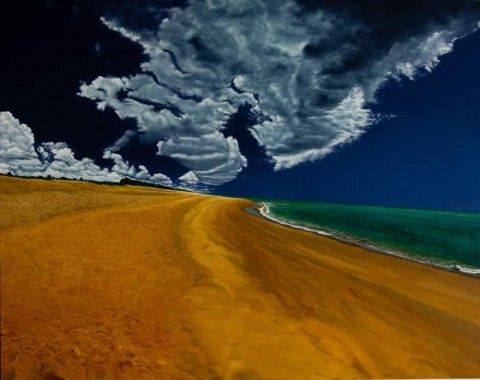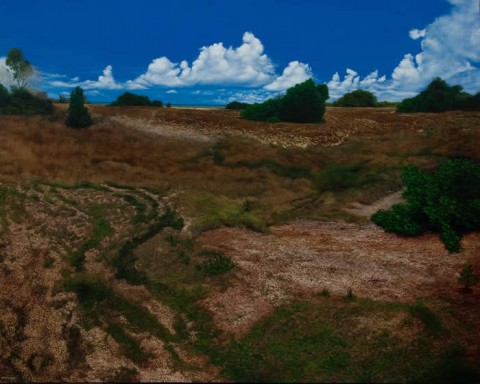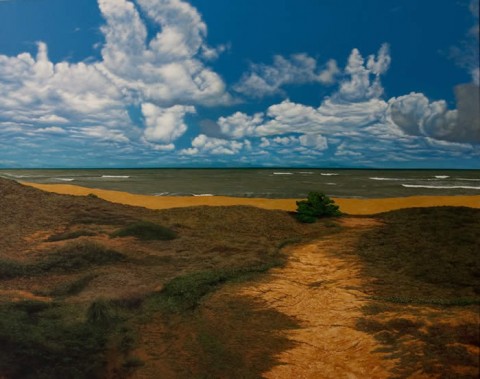

 Rantau Abang, Acrylic on canvas, 129.5cm x 162.5cm, 2008, Image Courtesy of Wei-Ling Gallery
Rantau Abang, Acrylic on canvas, 129.5cm x 162.5cm, 2008, Image Courtesy of Wei-Ling Gallery
Two Three Six at Wei Ling Gallery (1-24 June, 2009) satisfies with good old fashioned quality, quantity, attractiveness and emotiveness, convincing me that this painter is of a type that is rare to Asia, less rare in the West. Choosing a subject he has found to be personally important, Wei Meng both represents Malaysia and taps into a cross-cultural arena, with an admirable understanding of the value of landscape painting.
 Kuala Besut, Acrylic on canvas, 92cm x 244cm, 2008, Image Courtesy of Wei-Ling Gallery
Kuala Besut, Acrylic on canvas, 92cm x 244cm, 2008, Image Courtesy of Wei-Ling Gallery
This show is the culmination of an eight month journey through Terengganu, over which time the artist sketched, pondered, and photographed references to that which he intended to capture later on canvas. Terengganu is also the artist’s homeland, and such a personal stamp in art is never to be taken lightly. It is worth noting too, the significance of taking references back to the studio, rather than painting plein-air. Both approaches offer a different contribution to the art world. The deceptive simplicity of his works, void of controversy, combined with photorealism – a phenomenon now so common it has developed a reputation of “tackiness” – allow Wei Meng to be his own quiet, talented self. The 44 year old, who has taken part in group shows at the National Art Gallery, Kuala Lumpur and Seoul Museum of Art, Korea, apparently doesn’t fuel hype or interpretation of his art.
 Jambu Bongkok, Acrylic on canvas, 129.5cm x 162.5cm, 2008, Image Courtesy of Wei-Ling Gallery
Jambu Bongkok, Acrylic on canvas, 129.5cm x 162.5cm, 2008, Image Courtesy of Wei-Ling Gallery
A few works in lens-curvature panorama are a highlight. The naturalism in colour brightens the viewer’s day, instantly transporting them to a beach under a wide-open sky. The perspective leaves an imprint, land that reaches out to the viewer and under their feet, so they cannot escape the questions come to mind when one has nowhere left to go. If you have reached an edge, you must contemplate what is before you, or contemplate turning back. Also, there is no one around … are you lost? Are you trying to be alone? To humans, nature and scenery evoke gut-reactions and the location can be both relevant and irrelevant at the same time. That is, for all their stunning Malaysian-ness, these pieces also take you elsewhere, making it an ideal local exhibition. So, nothing is missing from Two Three Six. The show honours the skill of painting, and undoubtedly the major benefit to visitors is that, intentionally or not, Wei Meng’s love of Terengganu brings up those old favourites of, you guessed it, light and space.
 Gong Balai, Acrylic on canvas, 129.5cm x 162.5cm, 2008, Image Courtesy of Wei-Ling Gallery
Gong Balai, Acrylic on canvas, 129.5cm x 162.5cm, 2008, Image Courtesy of Wei-Ling Gallery
(SW)
~
Two Three Six continues at Wei-Ling Gallery, 8 Jalan Scott, Brickfields until 24 June.
For more images and info click here
~
Suraya Warden is an International Art Consultant with Honours in Art History & Curatorship. For work, she enjoys helping people build art collections and writes freelance on fashion and art.
Sorry, the comment form is closed at this time.
Do you mean old fashion sense of quality from a Western point of view?If so, which ‘West’ are you talking about?
I haven’t come across much of these in contemporary art, unless you’re talking about some backwater ‘West’.
Thank goodness it’s rare in Asia, because this type of painting is really just decorative and a little too vacuous.
Ouch!
Jbite = hater. Question: have you seen them in person?
I think these are good, not great, but maybe precursor to somethings significant. They have kind of Joseph Tan quality.
Here’s what I think are the possible implications of the question asked by SK when applied onto object based art in traditional gallery settings.
‘Have you seen them in person?’
NO?
->
You should not criticize what you have not experienced in person.
–>
If you do not live in Kuala Lumpur/X where most art objects are displayed, art should not concern you.
—>
If you are not the Prime Minister, seen midgets play basketball, or have the omniconsciousness of ‘god’, your opinions on such people and most things are often not valid and you should thus say nothing….unless its nice
YES?
->
You are then qualified to give critiques.
–>
Your opinion will still suck. The creator of the work has more weight than any of the viewers since he/she has seen it from the beginning.
–>
The artist, curator, experts and gallerist’s opinion will still suck when compared those of the collector since he/she can see it in person anytime on anyday for so long ownership is his/hers.
—>
Unless you are the owner or experiencer of something, say nothing….unless its nice
Laluna
Where did I say not qualified to give critique if you haven’t seen it in person. If you haven’t seen in person then your opinion is different right? At least you should say that.
UR right, all opinions suck.
Don’t have to be nice. Just be constructive. But want to lepas tension also ok. Just remember: you suck.
After all the artist has put in lot of effort, more than a comment anyway. Can acknowledge the effort and still be critic.
If you don’t want, your opinion is still here. Critic doesn’t mean choosing nice or hater. It’s called being smart.
Hi SK :)
Yeah, I like getting sucked into these endless art debates. I was just building up some possible assumptions from your question to jbite.
So cool I agree! Lets lepas some art steam and be smart and constructive together.
What is it that makes the painting ‘good but not great’?
Since these are photorealistic works, are you saying that in terms of technical skills, the degree of realism is still not convincing enough? The sand is not sandy enough, the water is not watery enough? etc.
How does Wei Meng’s work remind you of Joseph Tan’s art?
The senior artist had a very long career but few of his works are in view in public. I tried to search for his image online but all I found was the ‘Me and My Batik’ from 1975. This is the annoying thing about object based art. Can you specify the quality you are referring to?
Judging from the online pics alone, I would have preffered if the artist included more sky and clouds. The meticulous treatment of the earthy and grassy elements creates such a heavy feeling I feel as if my eyes were being sucked down by quick sand. Adding on to this weight is the cold feeling you get from such fine paintwork.
Maybe a lower horizonline and more clouds would counter such weakneses. Their depiction is so accurate I think a meteorologist would be able to tell you the weather and season the pictures are set in.
SK, if you want to feel the warmth and humidity of Malaysian nature, I recommend Wong Perng Fey. His creamy and abstract pieces are more to my taste. Give them a try.